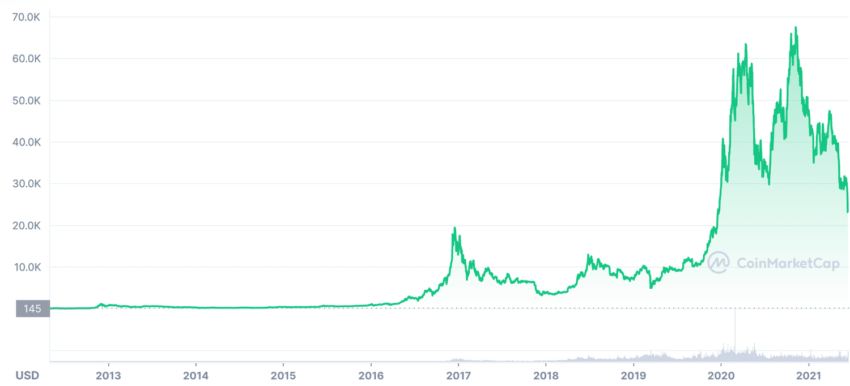Despite Bitcoin’s volatility and regulatory pressure, Michael Saylor, CEO of MicroStrategy, has emerged as one of the digital asset’s most fervent supporters. Saylor’s bullish stance has led to MicroStrategy amassing an astounding 140,000 BTC, causing ripple effects throughout the market.
In an April 5 tweet, Saylor boasted that MicroStrategy had acquired an additional 1,045 bitcoin for $29.3 million at an average price of $28,016 per bitcoin.
However, the question remains: what if Saylor’s predictions for Bitcoin’s future prove to be wrong? In this article, we explore the potential outcomes and implications of a misstep by one of Bitcoin’s most ardent advocates.
The Michael Saylor Phenomenon
As MicroStrategy’s CEO, Michael Saylor has become an influential figure in the cryptocurrency world. His company’s immense Bitcoin holdings and his unwavering belief in the digital asset have drawn both admiration and skepticism. With MicroStrategy now holding 140,000 BTC, the stakes are higher than ever. But what if Saylor’s predictions are off the mark? In this article, we delve into potential outcomes and implications.
The Fall of MicroStrategy
Should Saylor’s bullish outlook on BTC prove erroneous, MicroStrategy’s fortunes could plummet. The company’s massive Bitcoin investments highlight a lack of diversification, which could impact its financial health and investor confidence if Bitcoin’s value declines. Stakeholders might question Saylor’s leadership, and the company’s reputation could suffer.
A Ripple Effect in the Crypto Market
Saylor’s enthusiastic advocacy for Bitcoin has influenced many investors. A setback might cause wavering confidence in the digital asset. Consequently, the crypto market could see a broader sell-off, as investors shift their focus to alternative assets or traditional financial instruments.
MicroStrategy’s significant BTC holdings could also have a cascading effect on the market if the value declines or the company suddenly sells off its assets.
Saylor’s Point of No Return?
One might argue that Michael Saylor is too far into Bitcoin to reverse his stance now. Having invested a significant portion of his company’s funds, as well as his personal wealth, into the digital asset, it could be said that he has little choice but to continue promoting Bitcoin in the hopes of attracting more buyers to drive the price up.
Saylor’s optimistic outlook has helped fuel the digital asset’s growth. However, this heavy investment in BTC also raises questions about his objectivity and potential conflicts of interest.
As both his personal and company’s fortunes are tied to the success of Bitcoin, it’s worth considering whether his relentless promotion of the cryptocurrency runs on genuine belief, self-interest, or a combination of both.

If Saylor’s predictions about Bitcoin’s future fail to materialize, it could put both his personal reputation and MicroStrategy’s financial stability at risk. This situation may pose a dilemma for Saylor, as acknowledging any doubts or concerns about Bitcoin could further damage the asset’s value and his investments.
Ultimately, the extent to which Saylor is committed to Bitcoin, despite potential risks and uncertainties, is a testament to his conviction in the digital asset. However, investors and the broader crypto community should be mindful of the potential biases and incentives at play when considering Saylor’s stance on Bitcoin.
The all-time high of Bitcoin actually came in October 2021, when it briefly surpassed $67,000 USD. Since then, Bitcoin has experienced a significant decline in value, with fluctuations along the way.

Questioning Bitcoin’s Store of Value
Saylor argues that Bitcoin is digital gold, an ideal store of value for the modern era. However, Bitcoin’s price volatility has raised doubts about its ability to serve as a reliable store of value. During times of market turmoil, Bitcoin has exhibited sharp fluctuations, contradicting the notion of a stable safe haven. If Saylor’s predictions falter, the public could reevaluate this premise.
A Hedge Against Inflation?
Moreover, Bitcoin’s purported role as a hedge against inflation has been subject to debate. While some argue that its limited supply protects against the erosion of purchasing power, others point to instances where Bitcoin’s price failed to demonstrate a consistent inverse relationship with inflation rates.
As central banks worldwide continue to implement expansive monetary policies, the effectiveness of Bitcoin as an inflation hedge will face tests.
Gold and Altcoins
In light of these concerns, traditional assets like gold might regain favor, and altcoins with more stable price dynamics, such as stablecoins or even assets like Ethereum with its growing utility in the digital space, could vie for the store-of-value mantle.
Retail investors, confronted with Bitcoin’s shortcomings as a store of value or inflation hedge, might lose faith, leading to panic selling and further price declines. Consequently, the crypto market would need to adapt, focusing on the development and promotion of digital assets that can better fulfill these roles.
The Impact on Institutional Investment
Institutional investors have shown growing interest in Bitcoin, partly due to Saylor’s advocacy. However, if his bullish stance proves misguided, these organizations could withdraw from the market. Uncertain cryptocurrency regulations worldwide may affect Bitcoin’s value and adoption, potentially impacting MicroStrategy’s investment and other institutional investors’ confidence.
Such a retreat would have a knock-on effect, undermining the long-held belief that institutional investment is vital for cryptocurrency’s widespread adoption.
Saylor’s unyielding faith in Bitcoin has solidified him as a maximalist. If his assertions prove false, the maximalist ethos could weaken, and the crypto community might reevaluate the supremacy of Bitcoin. In turn, this could open the door for other cryptocurrencies to step into the limelight, encouraging a more diversified market.
Implications for Blockchain
Despite its association with Bitcoin, blockchain technology has applications far beyond cryptocurrency. Even if Saylor’s Bitcoin prophecies fall flat, blockchain technology will likely continue to thrive. Industries like supply-chain management, healthcare, and finance stand to benefit from the decentralized and transparent nature of blockchain.
For instance, blockchain can streamline supply-chain processes by providing real-time tracking of goods, reducing fraud, and enhancing collaboration among stakeholders. In healthcare, the technology can ensure the secure and efficient exchange of medical records, while in finance, blockchain can foster transparency and minimize transaction costs.
Regulatory Hurdles
Governments around the world have been grappling with the regulatory challenges posed by cryptocurrencies. If new regulations impose restrictions or bans on Bitcoin, this could hinder its adoption and affect its value. Retail investors might lose confidence in the face of such regulatory headwinds, further exacerbating price declines.
Countries like China have already imposed strict regulations on cryptocurrency trading and mining, raising concerns about the future of the industry.
On the other hand, nations like Switzerland and Malta have taken a more favorable approach, creating regulatory frameworks that support innovation and growth in the crypto space. El Salvador has adopted Bitcoin as legal tender. Yet, the varying regulatory landscape worldwide foments uncertainty for Bitcoin’s future and underscores the importance of monitoring developments in this area.
The Future Without Saylor’s Vision
If Saylor’s predictions fail to materialize, it doesn’t necessarily spell doom for Bitcoin. The digital asset has weathered numerous storms and continues to evolve. While his vision might falter, Bitcoin could still find success in other use cases. Or as a component of a broader digital currency ecosystem. For example, the Lightning Network, a second-layer solution for BTC, aims to address scalability issues and enable faster, cheaper transactions.
Bitcoin may serve as a medium of exchange. Not just a store of value, due to the development of the Lightning Network. Furthermore, DeFi platforms and NFTs illustrate the growing use cases for digital assets. Presenting potential for a more diverse and interconnected crypto ecosystem where Bitcoin could continue to play a significant role.
A Thought Experiment Worth Considering
While Michael Saylor’s bullish outlook on Bitcoin has garnered much attention, it’s essential to entertain alternative scenarios. By contemplating the potential consequences of Saylor being wrong, investors and the crypto community can better prepare for a wide range of outcomes.
In the ever-evolving world of digital assets, a balanced perspective is crucial for long-term success. The cryptocurrency landscape should be approached with both optimism and caution. This is due to diversification concerns, crypto market impact, regulatory challenges, and potential loss of retail investor confidence.
Regardless of Saylor’s predictions, the future of Bitcoin and the broader crypto ecosystem make for a fascinating and as yet unpredictable journey.
Disclaimer
Following the Trust Project guidelines, this feature article presents opinions and perspectives from industry experts or individuals. BeInCrypto is dedicated to transparent reporting, but the views expressed in this article do not necessarily reflect those of BeInCrypto or its staff. Readers should verify information independently and consult with a professional before making decisions based on this content. Please note that our Terms and Conditions, Privacy Policy, and Disclaimers have been updated.


